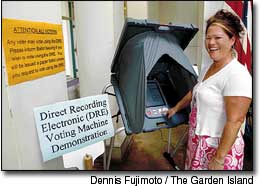Disabled and able-bodied voters at the general election tomorrow, Tuesday, Nov. 2, have the option of using either the traditional, blacken-the-circle style of choosing candidates and choices on charter and state constitutional amendments, or the Direct Recording Electronic (DRE) device,
Disabled and able-bodied voters at the general election tomorrow, Tuesday, Nov. 2, have the option of using either the traditional, blacken-the-circle style of choosing candidates and choices on charter and state constitutional amendments, or the Direct Recording Electronic (DRE) device, which will be at every polling place from Kekaha to Hanalei, and also available at Ni‘ihau School.
Many people used the DRE to cast their choices during walk-in absentee balloting at the historic County Building last week.
The eSlate device has many features to allow disabled voters to cast ballots, and even in places where polling places are inaccessible to those in wheelchairs or with other disabilities, poll workers can bring the machines to voters’ cars, state elections officials said.
People can listen to the words contained on the ballot with headphones, or bring their own neckloops if they prefer.
Jelly switches or sip ‘n’ puff devices may also be used if voters can’t operate the wheels and buttons of the eSlate system.



